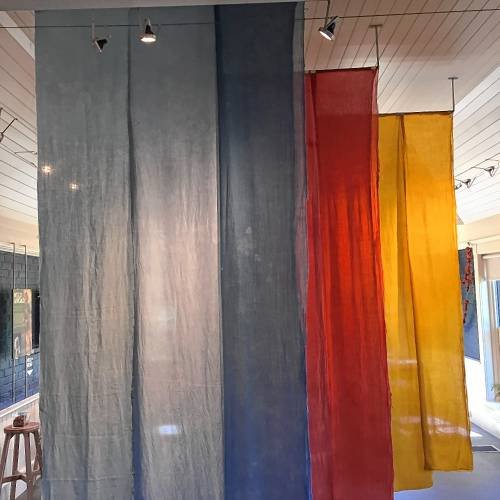Early this year, Smith College in Northampton was ready to present its glorious annual Spring Bulb Show. However, as we know, that show never opened. Like so many other events, the bulb show was shut down because of the newly blossoming Covid-19 pandemic.
I was fortunate enough to visit the Lyman Plant House just before the term ‘COVID’ was known everywhere. I got to visit the space used for the Bulb Show, although by then preparations had been called to a stop. Fortunately, I was still able to view a magical and colorful textile exhibit, “The Art and Science of Dyeing,” which was in place in the school’s Church Exhibition Gallery.
Michelle Parrish, who made those beautiful textile panels, worked with Sarah Loomis, the director of education at the college’s Botanic Garden, to put the exhibit together. Parrish told me that Loomis was the mastermind behind the design and installation. She also wrote all the interpretive information about plants and dyes on the wall panels. Theirs was a close collaboration, making Parrish responsible for choosing the dye plants that would be used and then cutting, washing, mordanting and dyeing all the cloth.
Parrish has been dyeing textiles and growing dye plants in her garden for 20 years. She set up the nine-foot panels of linen, silk, and wool in shades of blue, red, and yellow, orange, and green that showed the reaction of dyes on different textiles.
Parrish is a woman who has been playing with different crafts ever since she was a child. When she was 16 years old, she tried making a plant dye but failed and put the idea aside. She made pottery for several years and then learned to weave. In 1999, she became very serious about learning to weave and spin. At the same time, she began “to grow dye plants so that she could make textiles from the garden to finish.”
Because of the pandemic, Parrish, the creator of this exhibit, and I met over the telephone.
Along with the textile panels, there were informational panels on the wall with information about the plants that dyers use. Centuries ago, weavers had to make their own dyes out of plants, or else all textiles would be the basic color of the cotton, wool, or linen. In many cases, dyeing was its own specialized craft, separate from weaving. It is hard to think about a world where all textile dyes were derived from plants, minerals, or insects. Before 1860, this was true.
The wall panels explained that plant dyes were used centuries ago. It took me a while to understand that these names, madder and weld and woad are plants and that the plants date back to ancient Egypt and earlier. Madder alone makes red and orange dyes. Madder and weld are plants that make shades of red and yellow dyes.
Weld and woad plants make shades of green dyes. The green leaves of the woad plant contain the same source of blue as other indigo-bearing plants
An essential process of dyeing textiles is, to begin with, a mordant, or a dye fixative. Without a mordant, dyed textile will fade over time because of washings. However, Parrish explained that “woad and indigo do not require a mordant as the vat-making process involves unique chemical processes that allow physical bonding with the fibers.”
As an example of the dyeing process, Parrish gave me the instructions for making a yellow dye from marigold petals. Unfortunately, the process is too long for my column. I will describe the process briefly and recommend a visit to her blog, localcolordyes.com, for more information.
Equipment including a stainless steel two-gallon pot that will never be used for cooking, along with a thermometer, measuring spoons, a scale, and a washtub is essential.
Fiber must be washed or “scoured’ to prepare it for mordanting. It needs to be washed and dried. It can be put into the mordant while wet, or after it is dried. The mordant for wool fiber is aluminum sulfate (usually referred to as alum). The type of mordant depends on the fiber. The fiber needs to be weighed when dry.
The mordanting process will begin with measuring the weight of fiber to determine the measurement of mordant in hot water. The fiber may soak overnight in the mordant.
Then, it’s time to dye. The weight of fresh marigold flowers needs to be at least three-or-four times the weight of the fiber. For example, 2 ounces of fiber will need 6 or 8 ounces of marigolds. Dried marigolds will need a one-to-one ratio. Put the marigolds in a pot of water and bring it to a temperature of 180 degrees Fahrenheit.
Fiber should be completely wet when put in the dye. Bring the temperature back to 180 degrees Fahrenheit and maintain it for an hour. Then allow fiber to cool in a dyebath.
Remove the fiber from the dyebath, hang it carefully out to dry. Once it’s dry, wash it with biodegradable detergent and rinse repeatedly until rinse water is clear. Hang the fiber out to dry.
Parrish will be teaching a workshop at Snow Farm in Williamsburg on the weekend of Sept. 19 and 20 titled “Roots, Shoots, Leaves, and Flowers: Local Plants to Dye For.” If you would like to learn more about growing and using dye plants to dye woolen and linen yarns, registration is still open. Snow Farm has made careful arrangements that will enable students to maintain distance while they work. Much of the workshop will take place outdoors.
Michelle Parrish. For the Recorder/Pat Leuchtman
Plant dyed panels on display at Church Exhibition Gallery at Smith College in Northampton. For the Recorder/Pat Leuchtman
Michelle Parrish grows dye plants like woad in her own garden. For the Recorder/Pat Leuchtman
Yarn dyed with woad after it has been neutralized and rinsed. For the Recorder/Pat Leuchtman
Woad may look yellow in the pot, it turns to indigo blue as the oxidation process continues. For the Recorder/Pat Leuchtman

